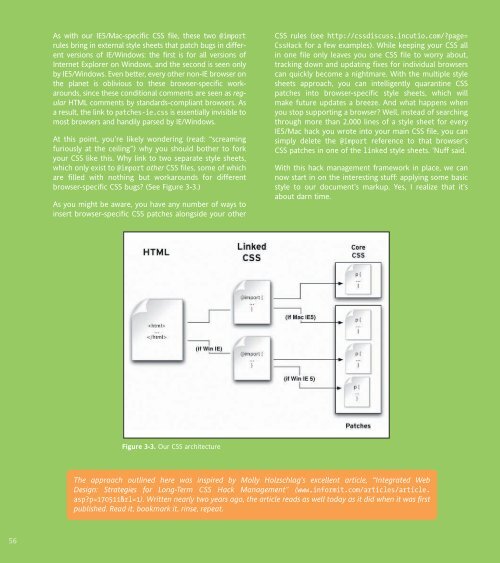WEB STANDARDS CREATIVITY
WEB STANDARDS CREATIVITY
WEB STANDARDS CREATIVITY
Create successful ePaper yourself
Turn your PDF publications into a flip-book with our unique Google optimized e-Paper software.
56<br />
As with our IE5/Mac-specific CSS file, these two @import<br />
rules bring in external style sheets that patch bugs in different<br />
versions of IE/Windows: the first is for all versions of<br />
Internet Explorer on Windows, and the second is seen only<br />
by IE5/Windows. Even better, every other non-IE browser on<br />
the planet is oblivious to these browser-specific workarounds,<br />
since these conditional comments are seen as regular<br />
HTML comments by standards-compliant browsers. As<br />
a result, the link to patches-ie.css is essentially invisible to<br />
most browsers and handily parsed by IE/Windows.<br />
At this point, you’re likely wondering (read: “screaming<br />
furiously at the ceiling”) why you should bother to fork<br />
your CSS like this. Why link to two separate style sheets,<br />
which only exist to @import other CSS files, some of which<br />
are filled with nothing but workarounds for different<br />
browser-specific CSS bugs? (See Figure 3-3.)<br />
As you might be aware, you have any number of ways to<br />
insert browser-specific CSS patches alongside your other<br />
Figure 3-3. Our CSS architecture<br />
CSS rules (see http://cssdiscuss.incutio.com/?page=<br />
CssHack for a few examples). While keeping your CSS all<br />
in one file only leaves you one CSS file to worry about,<br />
tracking down and updating fixes for individual browsers<br />
can quickly become a nightmare. With the multiple style<br />
sheets approach, you can intelligently quarantine CSS<br />
patches into browser-specific style sheets, which will<br />
make future updates a breeze. And what happens when<br />
you stop supporting a browser? Well, instead of searching<br />
through more than 2,000 lines of a style sheet for every<br />
IE5/Mac hack you wrote into your main CSS file, you can<br />
simply delete the @import reference to that browser’s<br />
CSS patches in one of the linked style sheets. ’Nuff said.<br />
With this hack management framework in place, we can<br />
now start in on the interesting stuff: applying some basic<br />
style to our document’s markup. Yes, I realize that it’s<br />
about darn time.<br />
The approach outlined here was inspired by Molly Holzschlag’s excellent article, “Integrated Web<br />
Design: Strategies for Long-Term CSS Hack Management” (www.informit.com/articles/article.<br />
asp?p=170511&rl=1). Written nearly two years ago, the article reads as well today as it did when it was first<br />
published. Read it, bookmark it, rinse, repeat.















